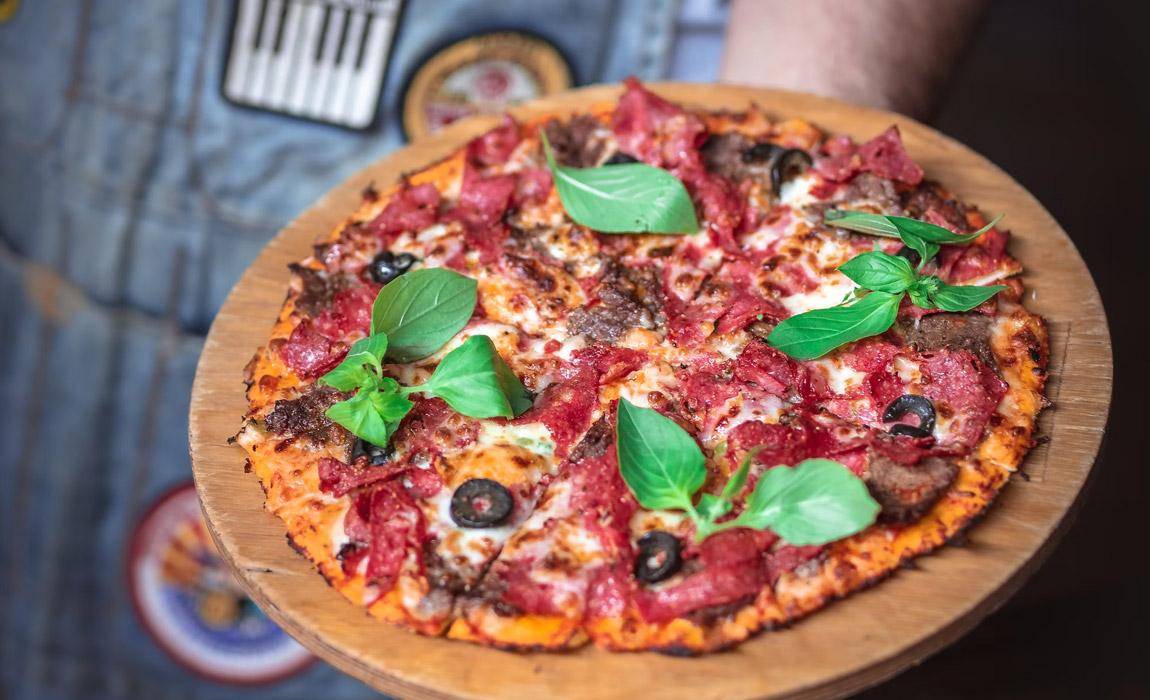Yes, you can eat pizza with acid reflux and GERD - you just need to make strategic ingredient swaps that won't trigger heartburn. Thin crusts, low-acid sauces, and lean toppings let you enjoy pizza night without paying for it later. This guide covers the best GERD-friendly pizza combinations, which toppings to avoid, and why your crust choice matters more than you think.
Do You Use CBD Products For Men's Health Issues?
- Specific pizza combinations that satisfy cravings without triggering GERD symptoms
- Ingredient swaps that work whether you're ordering delivery or making pizza at home
- The science behind why certain toppings cause problems so you can make informed choices on the fly
- Strategies for enjoying pizza during game day, guys night, or weekend gatherings without regretting it later
- A potential game-changer most guys overlook: why gluten-free crust might solve your problem entirely
- Can You Eat Pizza With GERD?
- Understanding Why Pizza Triggers Acid Reflux
- Best Pizza for Acid Reflux: GERD-Friendly Combinations
- How to Avoid Heartburn After Eating Pizza
- Pizza Toppings That Trigger Acid Reflux (And What to Order Instead)
- Gluten-Free Pizza Dough: A Potential Solution Worth Trying
- When to See a Doctor
- Build Your Perfect GERD-Friendly Pizza Starting Tonight
Picture this: it's Saturday night, the game's on, and someone suggests ordering pizza. If you've got acid reflux, that moment of anticipation turns into mental math - is it worth the heartburn that'll keep you up at 2 AM? The good news is you don't have to choose between joining the group and protecting your gut. With the right approach, pizza night stays on the menu.
Can You Eat Pizza With GERD?
The short answer is yes, but not the greasy, loaded-up pie you might be craving. Traditional pizza combines three major acid reflux triggers: acidic tomato sauce, high-fat cheese, and greasy meat toppings. Throw in some spicy pepperoni, wash it down with a few beers, and you've created the perfect storm for a rough night.
The key is understanding which components cause problems and making targeted swaps. You don't need to reinvent pizza entirely - sometimes switching from a meat lovers to a white pizza with grilled chicken makes all the difference.
Understanding Why Pizza Triggers Acid Reflux
Before diving into solutions, it helps to know what you're working against. Acid reflux occurs when stomach acid flows back into your esophagus, causing that burning sensation in your chest. GERD (gastroesophageal reflux disease) is the chronic version - acid reflux happening more than twice a week.
According to the National Institute of Diabetes and Digestive and Kidney Diseases, about 20% of Americans suffer from GERD. That's a lot of guys navigating the same pizza dilemma.
The Three-Part Problem
Pizza hits you with a triple threat:
The Crust: Thick, doughy crusts mean more carbs, which can increase stomach acid production. Deep dish and Detroit-style pizzas pack significantly more dough than a thin Neapolitan-style pie.
The Sauce: Tomatoes are highly acidic. That rich marinara that makes pizza taste like pizza is also one of the biggest GERD triggers out there.
The Toppings: Fatty cheeses and processed meats like pepperoni and sausage relax your lower esophageal sphincter (LES) - the valve that's supposed to keep stomach acid where it belongs. When the LES relaxes, acid escapes upward.
Common Risk Factors That Make It Worse
Certain factors amplify your acid reflux response to pizza:
- Excess weight puts pressure on your stomach and weakens the LES
- Smoking causes the LES to relax inappropriately
- Eating large portions overloads your digestive system
- Late-night eating means lying down before your stomach empties
- Alcohol both relaxes the LES and irritates the esophagus
- Carbonated drinks increase stomach pressure
If you're planning pizza for a late-night poker game or combining it with several beers, you're stacking the deck against yourself.

Best Pizza for Acid Reflux: GERD-Friendly Combinations
Here's where it gets practical. These pizza combinations minimize acid reflux triggers while still delivering on flavor. Whether you're ordering out or firing up the oven at home, these options work.
White Pizza (Best Overall Choice)
Skip the tomato sauce entirely. Olive oil, garlic, spinach, ricotta cheese, and a touch of Parmesan creates a satisfying pie without the acidity. This is your safest bet for a guys night when you want to enjoy multiple slices without consequences.
Grilled Chicken and Vegetables
Grilled chicken breast with zucchini, bell peppers, and red onions on a thin crust. Use olive oil as your base instead of marinara. Lean protein plus vegetables equals a pizza that's genuinely good for you.
Mediterranean Style
Hummus base, sliced tomatoes (small amount - less acidic than cooked sauce), cucumbers, kalamata olives, feta cheese, and oregano. The hummus provides creaminess without the fat content of heavy cheese.
Pesto Pizza
Basil pesto replaces the acidic tomato sauce while adding bold flavor. Top with sliced tomatoes, grilled chicken, and a light sprinkle of mozzarella or pine nuts.
Margherita (Modified)
Fresh mozzarella, fresh basil, and a thin layer of sauce. The key is going light on the sauce and cheese - a traditional Margherita uses less of both than American-style pizza.
Greek Pizza
Garlic-infused olive oil base, sliced tomatoes, red onions, black olives, feta cheese, and oregano. Another tomato sauce-free option with plenty of flavor.
Veggie Delight
Spinach, mushrooms, bell peppers, onions, and a light sprinkle of low-fat mozzarella on olive oil. Load up on vegetables and go easy on the cheese.
Seafood Pizza
Shrimp, crab meat, artichoke hearts, and roasted garlic with light cheese. Avoid cream-based sauces - stick with olive oil or a very light amount of white sauce.
BBQ Chicken (Cautious Choice)
Grilled chicken with red onions and a mild, low-acidity BBQ sauce. This one's riskier because BBQ sauce can be acidic, so choose your sauce carefully and use it sparingly.
Spinach and Feta
Spinach, crumbled feta, sliced tomatoes, and olive oil. Simple, flavorful, and unlikely to cause problems.
How to Avoid Heartburn After Eating Pizza
Beyond choosing the right toppings, how you eat matters as much as what you eat.
Choose Thin Crust
Thin crust means less dough, which means less acid production in your stomach. Skip the deep dish when you're watching your reflux. A crispy thin crust also tends to be more satisfying per bite, so you may eat less overall.
Go Easy on Cheese
Full-fat cheese is a major trigger. Ask for light cheese or choose pizzas that use smaller amounts of higher-quality cheese (like fresh mozzarella) rather than piles of shredded low-moisture mozzarella.
Avoid Trigger Toppings
Skip these: pepperoni, spicy Italian sausage, jalapeños, banana peppers, extra cheese, and anything described as "loaded" or "supreme."
Choose these instead: grilled chicken, shrimp, mushrooms, spinach, bell peppers, artichoke hearts, and fresh tomatoes (in moderation).
Watch Your Portions
Two slices of a GERD-friendly pizza beats four slices of a trigger-loaded one. Overeating is one of the fastest ways to cause acid reflux regardless of what you're eating.
Time It Right
Eat at least three hours before lying down. If pizza night runs late, stay upright - sit on the couch and watch another episode rather than heading straight to bed.
Skip the Beer (Or Limit It)
Alcohol relaxes the LES and irritates your esophagus. If you're already eating a potential trigger food, adding beer makes reflux significantly more likely. Consider switching to water or a non-carbonated, non-caffeinated drink.
Pizza Toppings That Trigger Acid Reflux (And What to Order Instead)
Understanding which toppings cause problems - and what to swap them for - helps you build a better pizza and apply these same principles to meals beyond pizza night.
| Trigger Category | Problem Toppings | Why It's Bad | Better Swap | Broader Application |
|---|---|---|---|---|
| High-Acid | Marinara sauce, sun-dried tomatoes, pickled vegetables | Increases stomach acid production and irritates esophagus | Olive oil base, pesto, white sauce, hummus | Choose cream-based pasta sauces over marinara; use balsamic reduction sparingly |
| High-Fat | Pepperoni, sausage, bacon, extra cheese, cream sauces | Relaxes LES and slows digestion, keeping acid in stomach longer | Grilled chicken, shrimp, turkey, light mozzarella, ricotta | Grill meats instead of frying; choose lean cuts; go easy on cheese in all dishes |
| Spicy | Jalapeños, banana peppers, hot Italian sausage, red pepper flakes, spicy marinara | Directly irritates esophageal lining and increases acid | Bell peppers, roasted red peppers, mild seasonings, fresh herbs | Season with oregano, basil, and garlic instead of heat; avoid buffalo and hot sauces |
| LES Relaxers | Beer or wine with pizza, chocolate dessert after, mint garnish | Causes lower esophageal sphincter to open inappropriately | Water, non-citrus juice, herbal tea; fruit-based desserts | Limit alcohol with any meal; skip after-dinner mints; choose sorbet over chocolate |
| Common Irritants | Raw onions, heavy garlic, anchovies | Can trigger reflux in sensitive individuals | Caramelized onions (milder), roasted garlic, artichoke hearts | Cook alliums to reduce irritation; use herbs for flavor instead |
The patterns here extend well beyond pizza. Once you identify your personal triggers - fatty, acidic, spicy, or all three - you can apply these swaps to tacos, sandwiches, pasta, and pretty much anything else you eat. Keep a food diary for a few weeks to reveal patterns you'd otherwise miss.
Gluten-Free Pizza Dough: A Potential Solution Worth Trying
Here's something most guys don't consider: gluten-free pizza crust might solve your acid reflux problem even if you don't have celiac disease.
People with undiagnosed gluten intolerance often experience GERD symptoms that improve dramatically on a gluten-free diet. Gluten intolerance can damage the small intestine and contribute to various gastrointestinal issues, including acid reflux.
If you've tried everything else and still struggle with pizza, experiment with gluten-free crust for a few weeks. Many pizzerias now offer gluten-free options, and frozen gluten-free crusts have improved significantly in recent years.
Keep a food diary during this experiment. Note how you feel after regular crust versus gluten-free. You might discover that gluten was the hidden culprit all along.
When to See a Doctor
Occasional heartburn after a heavy meal is normal. But if you're experiencing acid reflux more than twice a week, it's time to talk to your doctor. Chronic GERD can lead to serious complications including damage to your esophagus and increased risk of esophageal cancer.
Lifestyle changes - including the dietary strategies in this guide - are the foundation of GERD management. But some guys need additional treatment, and there's no shame in that. Don't let pride keep you from getting help if diet changes alone aren't cutting it.

Build Your Perfect GERD-Friendly Pizza Starting Tonight
You don't have to avoid pizza - you have to build a better one. Swap marinara for olive oil or pesto. Choose grilled chicken over pepperoni. Go thin crust instead of deep dish. Order light cheese. These aren't sacrifices; they're optimizations that let you stay in the game while everyone else pays for their choices later.
Start with the white pizza or grilled chicken and vegetable combinations above - they work for almost everyone. Then experiment. Try gluten-free dough for two weeks and track the results. Pay attention to whether raw onions bother you but caramelized ones don't. Build your personal formula through deliberate testing, not random guessing.
Whether you're grabbing slices during a New York guys trip, hosting a guy's night in poker game, or just want pizza on a Tuesday, you now have the playbook. Pick a GERD-friendly combination, watch your portions, time it right, and enjoy your pizza without dreading what comes next. The best part: once you dial this in for pizza, the same principles - less acid, less fat, strategic swaps - work for everything else you eat.
